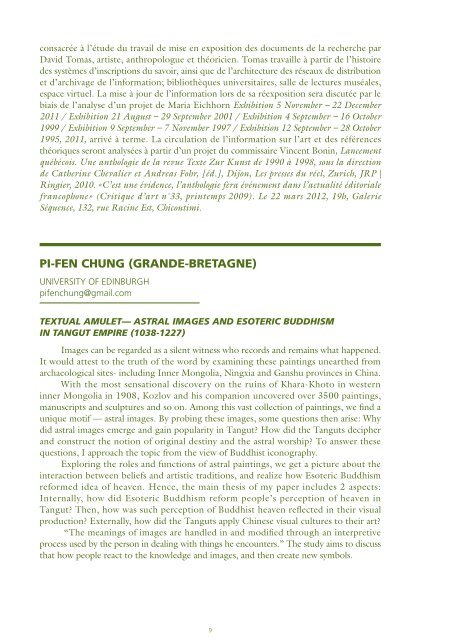COMMUNICATIONS - Réseau International pour la Formation à la ...
COMMUNICATIONS - Réseau International pour la Formation à la ...
COMMUNICATIONS - Réseau International pour la Formation à la ...
You also want an ePaper? Increase the reach of your titles
YUMPU automatically turns print PDFs into web optimized ePapers that Google loves.
consacrée <strong>à</strong> l’étude du travail de mise en exposition des documents de <strong>la</strong> recherche par<br />
David Tomas, artiste, anthropologue et théoricien. Tomas travaille <strong>à</strong> partir de l’histoire<br />
des systèmes d’inscriptions du savoir, ainsi que de l’architecture des réseaux de distribution<br />
et d’archivage de l’information; bibliothèques universitaires, salle de lectures muséales,<br />
espace virtuel. La mise <strong>à</strong> jour de l’information lors de sa réexposition sera discutée par le<br />
biais de l’analyse d’un projet de Maria Eichhorn Exhibition 5 November – 22 December<br />
2011 / Exhibition 21 August – 29 September 2001 / Exhibition 4 September – 16 October<br />
1999 / Exhibition 9 September – 7 November 1997 / Exhibition 12 September – 28 October<br />
1995, 2011, arrivé <strong>à</strong> terme. La circu<strong>la</strong>tion de l’information sur l’art et des références<br />
théoriques seront analysées <strong>à</strong> partir d’un projet du commissaire Vincent Bonin, Lancement<br />
québécois. Une anthologie de <strong>la</strong> revue Texte Zur Kunst de 1990 <strong>à</strong> 1998, sous <strong>la</strong> direction<br />
de Catherine Chevalier et Andreas Fohr, [éd.], Dijon, Les presses du réel, Zurich, JRP |<br />
Ringier, 2010. «C’est une évidence, l’anthologie fera événement dans l’actualité éditoriale<br />
francophone» (Critique d’art n˚33, printemps 2009). Le 22 mars 2012, 19h, Galerie<br />
Séquence, 132, rue Racine Est, Chicoutimi.<br />
pi-Fen Chung (grande-Bretagne)<br />
UNIVERSITy OF EDINBURGH<br />
pifenchung@gmail.com<br />
teXtuaL amuLet— astraL images and esoteric buddhism<br />
in tangut empire (1038-1227)<br />
Images can be regarded as a silent witness who records and remains what happened.<br />
It would attest to the truth of the word by examining these paintings unearthed from<br />
archaeological sites- including Inner Mongolia, Ningxia and Ganshu provinces in China.<br />
With the most sensational discovery on the ruins of Khara-Khoto in western<br />
inner Mongolia in 1908, Kozlov and his companion uncovered over 3500 paintings,<br />
manuscripts and sculptures and so on. Among this vast collection of paintings, we find a<br />
unique motif — astral images. By probing these images, some questions then arise: Why<br />
did astral images emerge and gain popu<strong>la</strong>rity in Tangut? How did the Tanguts decipher<br />
and construct the notion of original destiny and the astral worship? To answer these<br />
questions, I approach the topic from the view of Buddhist iconography.<br />
Exploring the roles and functions of astral paintings, we get a picture about the<br />
interaction between beliefs and artistic traditions, and realize how Esoteric Buddhism<br />
reformed idea of heaven. Hence, the main thesis of my paper includes 2 aspects:<br />
Internally, how did Esoteric Buddhism reform people’s perception of heaven in<br />
Tangut? Then, how was such perception of Buddhist heaven reflected in their visual<br />
production? Externally, how did the Tanguts apply Chinese visual cultures to their art?<br />
“The meanings of images are handled in and modified through an interpretive<br />
process used by the person in dealing with things he encounters.” The study aims to discuss<br />
that how people react to the knowledge and images, and then create new symbols.<br />
9



